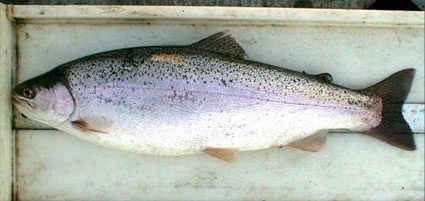Wednesday June 3, 2009

Dams reduce the abundance of wild anadromous fish, such as salmon and steelhead, by cutting off access to historical spawning habitat. Our drive for flood control and power generation results in changes to downstream habitat, often reducing woody debris and gravel recruitment, among other impacts. Conversely, due to the storage and release of cold water throughout the year, river reaches below dams can be transformed from an intermittent stream or warmwater fishery into a sustained coldwater fishery. The most productive habitat for invertebrates occurs in stable, continually submerged channels that are not too deep or fast flowing. Thus, artificial cold water fisheries can produce a lot of food, which in turn can produce a lot of fat trout. The above is a well-fed wild rainbow trout, the kind anglers call hogs, that we captured in one such stream.
Also, see a paper on the potential effects of more dams on salmon in California, and a recent news article on the Pacific Ocean Shelf Tracking project (POST), research questioning Columbia River dam impacts on juvenile salmon survival.
